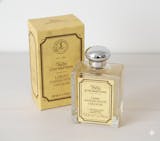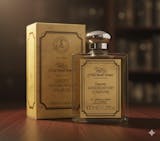Why Does Aftershave Burn? Here are 8 Reasons

The best way to soothe irritated post-shave skin is to use aftershave, but men often leave it out of their routines due to the sting. Why does aftershave burn if its goal is to treat and not agitate?
There are many reasons for this, and it goes beyond its list of ingredients.1 It may be your pre-shave routine or your shaving techniques.
- What Does Aftershave Do?
- Top 8 Reasons Why Aftershave Stings
- It has a high level of alcohol content.
- It is not compatible with your skin type.
- There is too much damage to your skin.
- You are treating it as a first-aid solution.
- You are using the wrong razor
- There is too much fragrance.
- It contains allergens.
- You are not shaving correctly
- Preventing Aftershave Burning Sensation
- Is It Important to Use Aftershave?
What Does Aftershave Do?
 Aftershaves soothe post-shave irritations and protect the skin from bacteria that can cause infection.
Aftershaves soothe post-shave irritations and protect the skin from bacteria that can cause infection.
Dr. Sonia Batra, MD, a dermatologist, explains that shaving leaves the skin susceptible to irritation.2 It creates tiny cuts and provides an entry point for microbes that become post-shave discomforts, including skin dryness and making it a little prickly and tight.
Aftershaves are products that solve skin problems, like razor burn, dry skin, and cuts after shaving. It disinfects the affected area with its astringent properties that eliminate and kill bacteria that cause acne on the face. Also, it contains moisturizing agents that soothe the skin, calm redness and prevent irritation.
Different Kinds Of Aftershave
Many consider purchasing it to provide a deluxe finish to a shave. It’s like choosing to wear perfume, especially if you use it as a splash. Be that as it may, aftershave comes in a variety, and not all of them leave a burning sensation.
The different kinds of aftershave are:
- Splash - a liquid-based aftershave with a light, watery consistency with the highest alcohol content.
- Lotion - a glycerin-based aftershave with a light, creamy consistency and little to no alcohol content.
- Balm - has the thickest consistency and is semi-solid in texture due to its viscous oil/wax base that melts on the skin upon application.
Aftershave splash has excellent anti-inflammatory properties that are best for tightening or closing open cuts and pores due to its high-alcohol content. Meanwhile, shave balms offer longer-lasting soothing and a deeper-nourishing treatment to many post-shave irritations. Lotions, on the other hand, provide a good balance of consistency and benefits from splash and balms.
Top 8 Reasons Why Aftershave Stings
 Eight Reasons Why Aftershave Stings
Eight Reasons Why Aftershave Stings
Some men’s love and hate relationship with aftershave comes from that distinct burning sensation upon application, while some men also think that the more it burns, the better it works. However, aftershave does not have to hurt.
Nonetheless, here are the top reasons why aftershave stings:
- It has a high level of alcohol content.
- It is not compatible with your skin type.
- There is too much damage to your skin.
- You are treating it as a first-aid solution.
- You are using the wrong razor
- There is too much fragrance.
- It contains allergens.
- You are not shaving correctly
It has a high level of alcohol content.
Almost all aftershave products, no matter the kind, contains alcohol in them. The more alcohol your aftershave has, the more it will sting. Although there is a burning sensation, alcohol does not actually burn the skin. According to scientists, alcohol triggers the receptors responsible for the sensation at a lower threshold, therefore, alarming the brain. It could also be an inflammation response.
Joseph Glajch, an analytical chemist at Momenta Pharmaceuticals in Cambridge, Massachusetts says, "it’s not destroying anything, [but] basically causing this receptor to get turned on."3
It is not compatible with your skin type.
If you are a beginner shaver, you probably opted for the aftershave splash at first, despite knowing that you have sensitive skin, ending up adding more salt to the wound—literally.
Not all aftershave types fare well with all skin types. For instance, those with sensitive skin should avoid alcohol-based aftershaves like splashes and lotions due to their alcohol content, while those with acne-prone skin should stay away from balms as they have pore-clogging ingredients like coconut oil or butter.4
There is too much damage to your skin.
Since the sole purpose of aftershave is to soothe and treat irritated skin after shaving, it always comes with antiseptic properties. Here is the problem: antiseptics and open cuts do not make a merry marriage.
If you have sensitive skin that is further irritated with nicks and microscopic cuts, no doubt applying aftershave to your skin will hurt. The more significant the problem is, the more it will yield to that dreaded burning sensation. This is because the antiseptic can also be an added irritant.
You are treating it as a first-aid solution.
Aftershave will surely burn when you are directly applying it to open wounds. If you are already experiencing razor burn, calm your skin through a cold compress to minimize the sensation, then apply your preferred aftershave product, which should have low alcohol content.
Meanwhile, if you have a major gash, stop your shaving nick from bleeding first. You can either put pressure on it by pinching or pressing it down with a cold compress.
You are using the wrong razor
 Razors with multiple blades impose more stress on the skin, helping increase aftershave sting.
Razors with multiple blades impose more stress on the skin, helping increase aftershave sting.
There is too much fragrance.
What makes aftershave products so irresistible for some men is their clean scent.6 There is nothing wrong with scented aftershave, except when there is too much—especially if it is synthetic.
Melissa Kanchanapoomi Levin, MD, a board-certified dermatologist and founder of Entière Dermatology in New York City, said in an interview, “Fragrances are known as one of the leading causes of allergic contact dermatitis (ACD) and can also cause other skin conditions such as irritant contact dermatitis, contact urticaria (hives from application of an allergen such as cinnamic aldehyde, menthol, balsam of Peru, cinnamates), photo-allergic reaction, [and] phototoxic reaction.”7
It contains allergens.
Going all-natural may seem the best option to combat aftershave sting, but not always. One wet shaver once said, “Sticking with essential oils is a good way to go, although it's no guarantee (there could be more than one allergy or sensitivity in play).”8 So, if you have any known allergies, it would be best to check the product’s list of ingredients. There may be some allergens that can irritate your skin further and cause serious skin problems.
You are not shaving correctly
If you use a mild aftershave product and still get that burning sensation upon application, your shaving technique may be the culprit. Take it from this Reddit user who gives an awesome take on what could be causing the sting: “you could be shaving too close and getting microscopic bleeders. That's what happens to me when I press a little too hard, especially when I'm using super sharp blades.”5
Preventing Aftershave Burning Sensation
 Choose the kind of aftershave that works best with your skin type and level of shaving expertise.
Choose the kind of aftershave that works best with your skin type and level of shaving expertise.
The best way to prevent aftershave sting is to look for the best aftershave that will fit the needs of your skin. You should consider its consistency, ingredients, and alcohol content. Do not forget to mind your shaving technique and the kind of razor you are using.
How to Choose the Best Aftershave
There is no one-size-fits-all regarding skincare products—yes, aftershave is one. That is why many factors can define the effect of your post-shave skin treatment. With that, here are the things you should remember when looking for the best aftershave:
- Men with normal skin without known allergies can use any kind of aftershave but will benefit best from aftershave balms since they contain natural ingredients, mild scent, and low alcohol content.
- Those with dry skin need to use an aftershave lotion or balm as these are more hydrating and since aftershave splash has a higher level of alcohol content that can further dehydrate and irritate the skin.
- For better sebum and oil control, an aftershave splash is the best bet for those with oily skin. Its astringent and antiseptic properties will help keep the skin tight and oil-free.
- Aftershave lotions are best for those with sensitive and acne-prone skin. Balms are too thick that it can clog pores, and an aftershave splash may be too potent that it can make your skin problems worse.
How to Use Aftershave Properly
Your shaving technique and product application determine how badly an aftershave could sting. Do not tackle your face with your razor and then slather on some post-shave treatment. You will surely leave it on fire. Instead, follow these steps if you want to use aftershave properly and prevent it from burning:
- Start with a pre-shave prep before a wet shave, as dry shaving increases the risks of irritation.
- Do not use a multi-blade razor. Instead, shave with a straight razor, shavette, or safety razor and shave along the grain or following the direction of your facial hair growth in one to two passes.
- Wash and clean your razor after every pass to keep the blade gliding smoothly and closely.
- Clean the face using cold water to remove excess lather. This will also contract the nerves and stop the bleeding from open wounds or nicks.
- Put only a small amount of your aftershave of choice on your palm and rub it gently on the skin. Apply more if needed.
Following a proper wet shave routine using a good razor and following up with hygienic post-shave care will surely lessen the burning sensation you might get from an aftershave.
Is It Important to Use Aftershave?
 Using natural aftershaves, like the Hemp Aftershave Balm from Naked Armor, allows your skin to heal properly after shaving, lessening post-shave consequences.
Using natural aftershaves, like the Hemp Aftershave Balm from Naked Armor, allows your skin to heal properly after shaving, lessening post-shave consequences.
Believe it or not, there are a lot of men with a bad shave-and-go habit who only use aftershave as a cologne to add a luxe scent to their grooming before heading out. Although it is true that you do not get shaving nicks and razor burns every time you shave, you still should use an aftershave product.
Using aftershave is an essential step in one’s shaving routine. It is not only for treating nicks, cuts, and other post-shave skin irritations. Aftershave products are excellent for disinfecting, soothing, and healing the skin, preventing more complicated problems like razor bumps, ingrown hair, and pseudofolliculitis barbae9 or infected hair follicles
So, do not skip this step. If you are afraid of the sting, you can try some natural and alcohol-free aftershave alternatives:
- Aloe vera: A natural remedy for burnt skin. It has anti-inflammatory and cooling properties, great for soothing and moisturization.
- Calendula oil: An antiseptic with anti-inflammatory, antifungal, and antibacterial properties that protect and reduce discomfort to your skin after shaving and is gentle for all skin types.
- Chamomile: A natural serum or toner with anti-inflammatory and anti-microbial properties to calm your skin and combat redness and irritation.
- Tea tree oil: Has terpenes that have excellent antibacterial, antifungal, and antimicrobial properties.
- Witch hazel: Works similarly to alcohol and has great anti-inflammatory and anti-viral qualities that can absorb excess oil and shrink pores.
There are plenty of safe, high-quality, alcohol-free aftershaves out there that you can purchase. They have astringent properties and are made of non-alcoholic antiseptic agents. Our Hemp Aftershave Balm, made with all-natural ingredients and packed with more than ten essential oils, specially chosen to nourish and cleanse your skin after shaving without the sting.
Do not forget to start your shaving the right way. Get a smooth and irritation-free shave by using a single-edge straight razor. Naked Armor razors are made to help you achieve a skin-level, close shave without minimal risks to microscopic cuts and blade-to-skin friction. Get your natural aftershave balm below:
More Naked Armor Reads:
How Long Does Razor Burn Last?
Which is Better: Straight Razor Vs. Modern Safety and Cartridge?
How To Get The Best Barber Shave At Home
References:
- What Ingredients are in Your Aftershave? Shave.net https://shave.net/blogs/shaving/aftershave-ingredients. October 22, 2018
- What Does Aftershave Even Do? A Doctor and Barber Explain. Country Highlights. https://countryhighlights.com/health/what-does-aftershave-even-do-a-doctor-and-barber-explain/. April 29, 2022
- A. M. Helmenstine, Ph.D.. Why Does Alcohol Burn on a Cut or Wound? Thought Co. https://www.thoughtco.com/why-alcohol-burns-on-a-cut-or-wound-608398. September 17, 2019
- K. McDonell, RD. Does Coconut Oil Treat Acne or Make It Worse? Healthline. https://www.healthline.com/nutrition/using-coconut-oil-to-treat-acne. August 4, 2021
- Is aftershave lotion supposed to burn when you apply it? Reddit. https://www.reddit.com/r/wicked_edge/comments/kiwsh8/comment/ggt9qbg/?utm_source=share&utm_medium=web2x&context=3
- Unscented or lightly scented aftershave like aqua velva. Badger & Blade. https://www.badgerandblade.com/forum/threads/unscented-or-lightly-scented-aftershave-like-aqua-velva.365127/
- T. Mustafa. Fragrance in Skin Care: Derms Weigh In on the Social Media Backlash Toward Scented Products. Pop Sugar. https://www.popsugar.com/beauty/fragrance-skin-care-debate-according-experts-47917326. October 26, 2020
- Wife is allergic to most aftershaves. Badger & Blade. https://www.badgerandblade.com/forum/threads/wife-is-allergic-to-most-aftershaves.472346/
- D. Norwood, PharmD, et al. Pseudofolliculitis Barbae: Prevention and Treatment. US Pharmacist. https://www.uspharmacist.com/article/pseudofolliculitis-barbae-prevention-and-treatment. October 14, 2016.





























Leave a comment